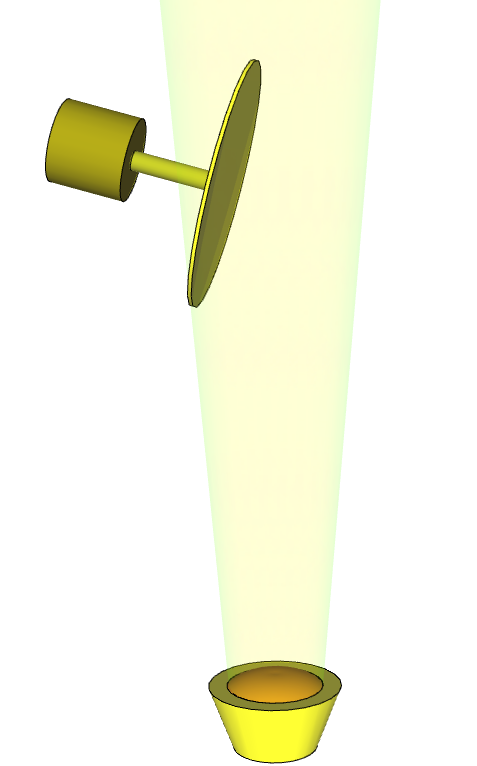Also known as sculptured thin films (STF), we can create columnar and spiral nanostructures using modified vacuum deposition techniques. Compared to conventionally packed thin films, these films can exhibit dramatically different optical, electrical and physical properties. This makes it possible to engineer their properties for specific applications. For example, the films can have much lower refractive indices, exhibit optical and electrical anisotropy and soften or melt at much lower temperatures.
The deposition is accomplished by holding the substrate at a steep inclination with respect to the incident flux (typically 85-degrees). This is known as Glancing Angle Deposition (GLAD). Due to the steep angle, each atom on the substrate creates a shadow behind it where no atoms can land. However, this method works only with materials that have a low enough surface mobility such that the atoms remain close to where they land. Examples of such materials include Ti, Cr, Co, SiO2 etc.. Soft materials such as Ag, Au, Al and Cu do not form distinct columnar structures due to their high surface mobilities. This can be largely corrected by cooling the substrate. We have been able to produce nanostructures with all of these soft materials by cryogenically cooling the substrate down to 80K.



Publications
1.
A. Belardini, G. Leahu, M. Centini, R. Li Voti, E. Fazio, C. Sibilia, Joseph W. Haus, Andrew Sarangan, D. Hooper, and V. K. Valev. “Effective chiral behavior on self-assembled tilted gold nanowires metasurface by means of linear and nonlinear optical techniques”. Proceedings of SPIE – The International Society for Optical Engineering, volume 9894, page 98941V, 2016. doi:10.1117/12.2230382
2.
Alessandro Belardini, Marco Centini, Grigore Leahu, David C. Hooper, Roberto Li Voti, Eugenio Fazio, Joseph W. Haus, Andrew Sarangan, Ventsislav K. Valev, and Concita Sibilia. “Chiral light intrinsically couples to extrinsic/pseudo-chiral metasurfaces made of tilted gold nanowires”. Scientific Reports, 6(1):31796, 2016. doi:10.1038/srep31796
3.
A. Belardini, A. Benedetti, M. Centini, E. Fazio, M. Bertolotti, C. Sibilia, Joseph W. Haus, and Andrew Sarangan. “Symmetry breaking in the second harmonic field of self-assembled metallic nanostructures”. Proc. SPIE – The International Society for Optical Engineering, volume 9502, page 950206. SPIE, 2015. doi:10.1117/12.2182759
4.
Alessandro Belardini, Marco Centini, Grigore Leahu, Eugenio Fazio, Concita Sibilia, Joseph W. Haus, and Andrew Sarangan. “Second harmonic generation on self-assembled tilted gold nanowires”. Faraday Discussions, 178:357–362, 2015. doi:10.1039/C4FD00200H
5.
Michael Benson, Piyush Shah, Michael Marciniak, Andrew Sarangan, and Augustine Urbas. “Optical Characterization of Silver Nanorod Thin Films Grown Using Oblique Angle Deposition”. Journal of Nanomaterials, 2014:1–8, 2014. doi:10.1155/2014/694982
6.
Piyush Shah, Dongquan Ju, Xiaoxu Niu, and Andrew M. Sarangan. “Vapor Phase Sensing Using Metal Nanorod Thin Films Grown by Cryogenic Oblique Angle Deposition”. Journal of Sensors, 2013:1–6, 2013. doi:10.1155/2013/823041
7.
Piyush J. Shah, Zhi Wu, and Andrew M. Sarangan. “Effects of CO2 critical point drying on nanostructured SiO2 thin films after liquid exposure”. Thin Solid Films, 527:344–348, 2013. doi:10.1016/j.tsf.2012.10.057
8.
Piyush Shah, Xiaoxu Niu, and Andrew Sarangan. “Effect of Cryogenic Substrate Temperature on the Growth of Ag and Cu Nanostructured Optical Metamaterials”. 2012 Symposium on Photonics and Optoelectronics, pages 1–2. IEEE, 2012. doi:10.1109/SOPO.2012.6270908
9.
Daniel Schmidt, Benjamin Booso, Tino Hofmann, Eva Schubert, Andrew Sarangan, and Mathias Schubert. “Monoclinic optical constants, birefringence, and dichroism of slanted titanium nanocolumns determined by generalized ellipsometry”. Applied Physics Letters, 94(1):011914, 2009. doi:10.1063/1.3062996
10.
D. Schmidt, B. Booso, T. Hofmann, E. Schubert, A. Sarangan, and M. Schubert. “Generalized ellipsometry for monoclinic absorbing materials: determination of optical constants of Cr columnar thin films”. Optics Letters, 34(7):992, 2009. doi:10.1364/OL.34.000992
11.
Mengshu Pan, Andrew Sarangan, and Qiwen Zhan. “Optical Birefringence of Nano-porous Dielectric Thin Films”. Frontiers in Optics 2008/Laser Science XXIV/Plasmonics and Metamaterials/Optical Fabrication and Testing, page FThR2, Washington, D.C., 2008. OSA. doi:10.1364/FIO.2008.FThR2